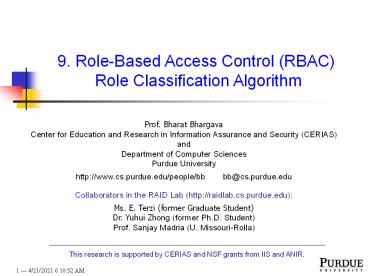9. Role-Based Access Control (RBAC) Role Classification Algorithm - PowerPoint PPT Presentation
Title:
9. Role-Based Access Control (RBAC) Role Classification Algorithm
Description:
9. Role-Based Access Control (RBAC) Role Classification Algorithm Prof. Bharat Bhargava Center for Education and Research in Information Assurance and Security (CERIAS) – PowerPoint PPT presentation
Number of Views:192
Avg rating:3.0/5.0
Title: 9. Role-Based Access Control (RBAC) Role Classification Algorithm
1
9. Role-Based Access Control (RBAC) Role
Classification Algorithm
Prof. Bharat Bhargava Center for Education and
Research in Information Assurance and Security
(CERIAS) and Department of Computer
Sciences Purdue University http//www.cs.purdue.ed
u/people/bb bb_at_cs.purdue.edu Collaborators in the
RAID Lab (http//raidlab.cs.purdue.edu) Ms. E.
Terzi (former Graduate Student) Dr. Yuhui Zhong
(former Ph.D. Student) Prof. Sanjay Madria (U.
Missouri-Rolla)
This research is supported by CERIAS and NSF
grants from IIS and ANIR.
2
RBAC Role Classification Algorithm- Outline
- 1) Introduction
- 2) Algorithm
- 2.1) Algorithm Preliminaries
- 2.2) Algorithm - Training Phase
- 2.3) Algorithm - Classification Phase
- 2.4) Classification Algorithm Pseudocode
- 3) Experiments
- 3.1) Experiment 1 Classification Accuracy
- 3.2) Experiment 2 Detection and Diagnosis
- 3.3) Experiment Summary
3
1) Introduction
E. Terzi, Y. Zhong, B. Bhargava et al., 2002
- Goals for RBAC Role Classification Algorithm
- Detect intruders (malicious users) that enter the
system - Build user role profiles using a supervised
clustering algorithm - Incorporate the method in RBAC Server
Architecture - RBAC Role Based Access Control
- Context
- Role server architecture that dynamically assigns
roles to users based on trust and credential
information - Role classification algorithm phases
- Training phase
- Build clusters that correspond to the role
profiles based on the previously selected
training set of normal audit log records - Classification phase
- Process on the run users audit records and
specify whether they behave according to the
profile of the role they are holding
4
2) Algorithm2.1) Algorithm Preliminaries
- Data format
Audit log record
X1, X2 ,,Xn, Ri
where
X1, X2 ,,Xn - n attributes of the audit log
Ri role held by user who created the log record
assumption
Every user can hold only one role
X1, X2 ,,Xn, Rj
X1, X2 ,,Xn, Ri
No records of the form
with Ri? Rj
5
2.2) Algorithm - Training Phase
- Training Phase Building the Cluster
- Create d dummy clusters, where d - nr of all
discrete system roles - Centroid - the mean vector, containing the
average values of the selected audit data
attributes of all the users that belong to the
specific role - a) For each training data record (Reccur ),
calculate its Euclidean - distance from each one of existing clusters
- b) Find the closest cluster Ccur to Reccur
- c) If role represented by Ccur role of Reccur
then cluster Reccur to Ccur - else create a new cluster Cnew containing
Reccur - Cnew centroid? Reccur
- Cnew role? Role of Reccur
6
2.3) Algorithm - Classification Phase
- Classification Phase
- Calculate distance between the newly produced
audit record Recnew of a user U and each
existing cluster - a) Find cluster Cmin closer to Recnew
- b) Find cluster Ccur closest to Recnew
- c) if role represented by Ccur role of Recnew
- then U is a normal user
- else U is an intruder and an alarm is raised
7
2.4) Classification Algorithm Pseudocode
- Training Phase Build Clusters
Step 2 for every training record Reci
calculate its Euclidean distance from existing
clusters find the closest cluster Cmin if
Cmin.role Reci.role then reevaluate the
attribute values else create new cluster Cj
Cj.role Reci.role for every
attribute Mk Cj.M k Reci.Mk
- Classification Phase Detect Malicious Users
Input cluster list, audit log record Rec for
every cluster Ci in cluster list calculate
the distance between Rec and Ci find the closest
cluster Cmin if Cmin.role Rec.role then
return else raise alarm
8
3) Experiments3.1) Experiment 1 Classification
Accuracy
- Goal
- Test classification accuracy of the method
- Data
- Training Set
- 2000 records
- Test Set Substi-
- tute 0 - 90 of
- records from the
- training set with
- new records
- Experiment results
9
3.2) Experiment 2 Detection Diagnosis
- Goal
- Test the ability of the algorithm to point out
misbehaviors and specify the type of misbehavior - Data
- Training Set
- 2000 records
- Test Set Modify
- the role attribute
- of 0-90 of
- the 2000 records
- from the training
- set
- Experiment results
10
3.3) Experiment Summary
- Accuracy of detection of malicious users by the
classification algorithm ranges from 60 to 90 - 90 of misbehaviors identified in a friendly
environment - Friendly environment - fewer than 20 of
behaviors are malicious - 60 of misbehaviors identified in an unfriendly
environment - Unfriendly environment - at least 90 of
behaviors are malicious)
11
Our Research at Purdue
- Web Site http/www.cs.purdue.edu/homes/bb
- Over one million dollars in current support from
- NSF, Cisco, Motorola, DARPA
- Selected Publications
- B. Bhargava and Y. Zhong, "Authorization Based on
Evidence and Trust", in Proc. of Data Warehouse
and Knowledge Management Conference (DaWaK),
Sept. 2002. - E. Terzi, Y. Zhong, B. Bhargava, Pankaj, and S.
Madria, "An Algorithm for Building User-Role
Profiles in a Trust Environment", in Proc. of
DaWaK, Sept. 2002 . - A. Bhargava and M. Zoltowski, Sensors and
Wireless Communication for Medical Care, in
Proc. of 6th Intl. Workshop on Mobility in
Databases and Distributed Systems (MDDS), Prague,
Czechia, Sept. 2003. - B. Bhargava, Y. Zhong, and Y. Lu, "Fraud
Formalization and Detection", in Proc. of DaWaK,
Prague, Czech Republic, Sept. 2003.
12
- THE END































